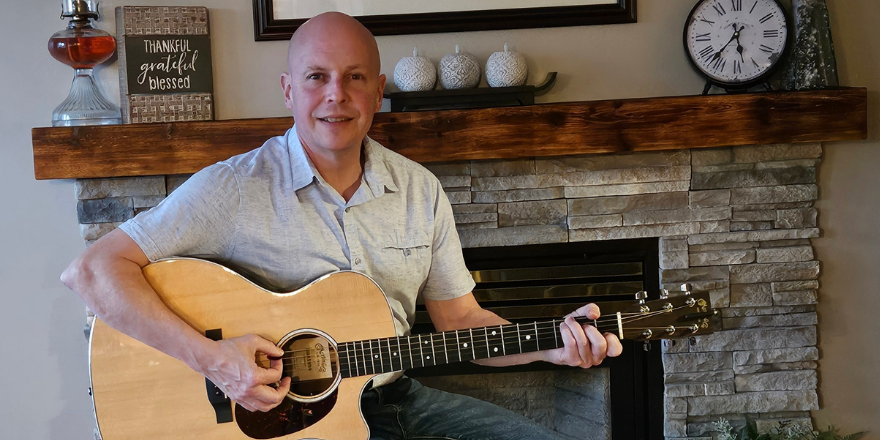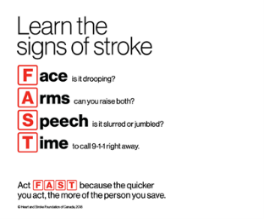Copy link URL:
Stories
How Endovascular Thrombectomy (EVT) Is Saving Lives
June 2, 2025
Just nine months ago, in September 2024, Pete Wilkins was going about his day as normal. He was running some errands with his son and had plans to meet with his mother at his home in St. Philip’s. Pete returned home just before 4:00 p.m. Right away, he knew something was wrong.
He looked at his mother and his wife, Melinda, and told them he didn’t feel well. Suddenly, he realized that he couldn’t speak and his right side went limp. He knew that he was having a stroke. What struck him in that moment was the look on his mother’s face – one of worry and concern.
What happened next helped ensure Pete received the care he needed as soon as possible. Because Melinda recognized the signs of stroke from learning about them from advertising and the media, she knew Pete was having a stroke. After helping him lie down, she called 911.
Within minutes, emergency responders including Newfoundland and Labrador (NL) Health Services’ emergency medical services (EMS) responded to Pete’s health emergency. He remembers everything vividly on the ride in the ambulance to the Health Sciences Centre in St. John’s and he credits everyone involved for the prompt care he received.
“I was very lucky. When I was coded in, the stroke team was just getting out of another procedure and they were waiting for me. I was lucky that the medical imaging team was ready to go. All the stars lined up so that it decreased how long I was in that stroke situation,” Pete says.
Dr. Marsha Eustace is a stroke neurologist with NL Health Services. Her main message to anyone who suspects they are having a stroke is to call 911. “The ambulance system is set up to respond to stroke as a medical emergency. Stroke patients need to be taken as soon as possible to a hospital that has stroke care capabilities. EMS know where the closest appropriate hospital is located and will directly transport patients to that location. They also pre-notify the receiving emergency department so that preparations can be made to further minimize any time delays on arrival.”
For Pete, that is exactly what happened. He was immediately assessed, and it was determined that he was a fit for endovascular thrombectomy (EVT), a state-of-the-art intervention where blood clots causing stroke are removed from medically eligible patients. This minimally invasive procedure is considered a best practice for stroke care in Canada and has been available since June 2022 in the Eastern-Urban Zone of NL Health Services. Since 2022, NL Health Services focused on building new processes, delivering targeted education, updating imaging equipment, and establishing clear criteria throughout the province to identify patients who are eligible for EVT. These coordinated efforts ensure that anyone experiencing a stroke in the province has access to EVT if it is recommended.
By 8:00 p.m., Pete had received EVT and was recovering in the intensive care unit. His stroke was caused by a blood clot in his brain that was one third the size of a grain of rice. Within four to five hours, Pete’s speech started to improve and by the morning he was able to speak full sentences. He passed all the cognitive and mobility assessment tests.
Dr. Nanette Hache is an interventional neuroradiologist with NL Health Services and she is one of three physicians responsible for assembling the team of interventional radiology nurses and technologist, that make sure the operating room is ready for EVT.
She says that once the patient has been deemed a candidate for EVT, arrangements are quickly made to transfer the patient to the angiography (a medical imaging technique) suite for EVT. “When there is a suspect EVT case being worked up, the angiography suite is held until we know if the patient will be an EVT candidate to prevent any delay in treatment. With our team and with anesthesia support, an interventional neuroradiologist will then perform EVT to re-establish blood flow to the brain.”

This time dependent procedure uses a catheter inserted usually in the right groin/femoral artery to remove a blood clot from large brain vessels. This restores blood flow to the brain, helping prevent further damage.
“When EVT is completed, we hope to prevent any further expansion of the stroke size and thereby improve patient recovery which would decrease stroke mortality and disability,” says Dr. Eustace. “When patients come in very quickly after the event, we may see immediate improvement when the clot is removed.”
That was certainly the case for Pete. He walked out of ICU two days after his stroke and was back to work in two weeks and driving in four weeks. Even though Pete had the option of post-stroke rehabilitation at the Dr. L.A. Miller Centre, he didn’t feel it was necessary based on the minor side effects he was experiencing and in consultation with this care team. Instead, he preferred to use his work and his hobbies to help him with some of the side effects. Pete found his work in the grocery industry helped him with his speech issues such as relearning to form larger words, and his hobby of playing guitar helped him improve his fine motor skills.
Pete credits the access to EVT and the level of care he received for his short recovery and minor post-stroke issues. “It was the timelines from start to finish. The quality of care I got from everyone and the new procedure. Everything lined up so perfectly.”
The positive benefits of EVT for eligible patients is one of the main reasons that this procedure is now available for everyone in Newfoundland and Labrador. EVT can cut down on serious side effects, thereby reducing hospital stays and what can sometimes be lengthy rehabilitation. That’s a win-win for eligible patients and the health-care system.
EVT can be offered up to 24 hours after the onset of symptoms, in select cases. If an individual is experiencing a stroke anywhere in Newfoundland and Labrador, health-care professionals are trained to identify if the individual is an EVT candidate and that individual is then transported as soon as possible to the Health Sciences Centre in St. John’s for treatment, if appropriate. This is possible through partnerships with emergency medical services/air ambulance, emergency medicine, neurology, radiology, interventional neuroradiology, critical care, intensive care units, and anesthesiology across NL Health Services.
For both Dr. Eustace and Dr. Hache, the most important take away for anyone experiencing a stroke is to call 911 immediately. They cannot emphasize enough that “time is brain” and they encourage everyone to learn the FAST signs of stroke. The quicker someone experiencing a stroke gets to the hospital, the better chance of receiving treatment for the best possible outcome.

Thanks to EVT, Pete’s stroke had no major repercussions on his quality of life. He acknowledges that a lot of people may not have the same results post-stroke, but having a stroke has changed his perspective on life.
“I don’t sweat the small stuff anymore because life is too short and it can change in a hurry,” he says. “A lot of times, you don’t know when it’s going to happen. So, if you want that truck or that trip and you have the money, get it. If there’s something you can do, do it. Tomorrow may not be there to do it.”
Philanthropy in Action
June is Stroke Awareness Month and it is important to recognize that every stage of a stroke patient’s journey is critical. The quality of care during these times can have a profound impact on a patient’s recovery and long-term outcomes. The Health Care Foundation is committed to supporting stroke across the continuum.
At the Dr. L. A. Miller Centre, the Health Care Foundation’s investments has enabled access to specialized rehabilitation tools, including functional electrical stimulation bikes, harness and track systems, cross-trainers, ultrasound equipment, and mobility aids. These tools are essential to help stroke survivors rebuild strength, mobility, and independence.
The Health Care Foundation aims to improve care pathways and advancing rehabilitation techniques—ensuring patients receive the best possible support throughout their recovery.
Learn more about the Health Care Foundation at healthcarefoundation.ca.
